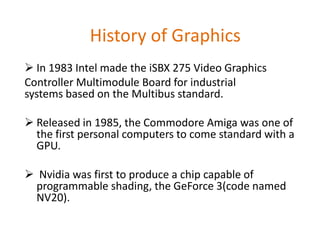Graphics card
- 3. History of Graphics ? In 1983 Intel made the iSBX 275 Video Graphics Controller Multimodule Board for industrial systems based on the Multibus standard. ? Released in 1985, the Commodore Amiga was one of the first personal computers to come standard with a GPU. ? Nvidia was first to produce a chip capable of programmable shading, the GeForce 3(code named NV20).
- 4. ?Further,many more graphics cards were introduced like The Nvidia GeForce256(also known as NV10) the ATI Radeon 9700 (also known as R300), etc which have brought about a revolutionary change in graphics today!
- 5. Guess this graphics card!
- 6. You don't know where you are going till you know where you came from. It’s important to know the history ?
- 7. S3 VIRGE ? First 3D graphics card
- 8. ATI RAGE II ? 8 mb on chip ram, 64 bit
- 9. RENDITION VERITE ? Pipeline configuration of 1/1/1 (textures/pixels/Z).
- 10. 3dfx VOODOO 1 ? Breakthrough, introduced the concept of dedicated graphics card. ? Used to perform only 3d operations. Consumers still needed 2d cards separately.
- 11. ATI RAGE PRO ? First card to support agp 2x. ? Integrated floating point set up engine to generate 1.2 million triangles per second.
- 12. NVIDIA NV3 ? Designed with Microsoft's DirectX 5 API in mind. ? 4MB of memory, a 100MHz core clockspeed, 1.6GB/s of bandwidth, a 206MHz RAMDAC, compatible with AGP 2X. ? It was also a 2D/3D combo card ? 3.5 million transistors
- 13. INTEL i740 ? Strengthened GMA (Graphics media accelerator)
- 14. ATI Rage Fury Maxx ? Two graphics chips
- 15. Power VR Series 2 ? Could process up to 4 million polygons per second. ? Unique (at the time) approach to 3D computing. ? Rather than display images by processing polygons one at a time -- through the CPU and the GPU -- the Neon 250 took a 'tile- based' approach. Each 3D scene would be broken up into separate small tiles and independently processed before being sent through the GPU
- 16. Where do you find it on the motherboard
- 17. FOR LAPTOPS…
- 18. Graphics Processing Unit RAMDAC Heat Sink A modern video card consists of a Printed circuit board on which the components are mounted. Video Video BIOS memory
- 19. Basic O/P Ports… ?Video Graphics Array (VGA) (DE-15) ?Digital Visual Interface (DVI) ?Video In Video Out (VIVO) for S-Video, Composite video and Component video ?High-Definition Multimedia Interface (HDMI) ?Display Port ?Others ? DMS-59 ? Component video ? And others…
- 20. What is GPU?? ? A GRAPHICS PROCESSING UNIT or GPU is a specialized microprocessor that discharge and accelerates 3D or 2D graphics. ? Used in embedded systems, mobile phones, personal computers, workstations and game consoles.
- 21. CPU v/s GPU
- 30. Integrated Graphics Card 1. An integrated graphics processing unit (GPU) doesn't use its own RAM. 2. The video card can use anywhere between one and five percent of the available memory for graphics processing. Benefits: 1. It is cheaper, which in turn means a less expensive computer. 2. Generates much less heat than a dedicated video card and uses less power. 3. Perfect for people doing everyday graphics processing.
- 31. Dedicated Graphics Card 1. GPU has its own independent source of video memory. 2. Dedicated cards are perfect if you are into serious gaming or are a professional graphic designer. Drawbacks: 1. If you don't have the appropriate design or a good fan, these video cards will get warm. 2. Using a laptop with dedicated graphics card will decrease the battery life. 3. You should also expect to pay more for this kind of card.
- 32. GPU SWITCHING… ? Used on laptops with multiple graphics controllers. The standard situation gathers an integrated graphics device and a discrete video card, the latter consuming more power than the first but also providing higher 3D performances. ? Longer battery times when no high- performance graphics is needed.
- 33. AMD ?Super baby fusion ?Generic cards ?Crossfire
- 37. ?Integrated Graphics Chipsets are Improving ?Tablets Cannibalize PCs ? Dedicated Graphics Cards Are Moving to Higher End Systems ? More than Just Graphics
- 38. ? But That doesn’t mean that graphics cards are on the way out. ? Rather, graphics cards are likely going to evolve to adapt to other tasks beyond graphics processing. Meanwhile, expect integrated graphic chipsets to continue to improve and meet the needs of the consumer market.







































